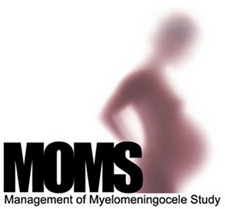Results from an NICHD-funded study show benefits and risks of prenatal surgery to repair the primary defect in the most severe form of spina bifida

Spina bifida is a serious birth defect that affects about three to four out of every 10,000 live births in the United States. Spina bifida occurs when the spinal column—including the bones of the spine, muscles, and skin—does not develop or close completely around the spinal cord while a baby is growing in the womb.
The most common and severe form of spina bifida, called myelomeningocele, occurs when the spinal cord and nerves stick out through an opening in the spinal column. Infants born with myelomeningocele can experience paralysis, problems with nerve function, and a fluid buildup in their brains (called hydrocephalus), which can cause additional brain and nerve damage.
The standard treatment for this condition involves surgery to repair the opening in the spinal column after the baby is born. In the Management of Myelomeningocele Study (MOMS), researchers have been comparing outcomes from the standard treatment to outcomes from a newer treatment—surgery to repair the defect while the baby is still in the womb.
The encouraging results from MOMS, which included NICHD researchers working with colleagues at four institutions, were published online on February 9, 2011, in the New England Journal of Medicine. The researchers found better overall outcomes for those who got surgery while in the womb, compared to those who received the surgery after birth. You can read more about the results at Surgery on Fetus Reduces Complications of Spina Bifida.
NICHD researchers and colleagues at the Children's Hospital of Philadelphia, the University of California, San Francisco, Benioff Children's Hospital, Vanderbilt University Medical Center in Nashville, and the George Washington University Biostatistics Center in Washington, D.C. led the study, which began recruiting participants in 2003.
The study was originally designed to include 200 pregnant mothers who were carrying a child with myelomeningocele. After only 183 women were enrolled, an independent data and safety monitoring committee recommended that the trial be stopped because it was clear that benefits of doing the prenatal surgery were greater than those from the traditional surgery after birth.
Even though the prenatal surgery has a number of benefits, it also carries significant risks. Prime among them is the increased chance of early delivery, which can cause multiple problems for the infant, including breathing difficulties. In addition, pregnant women who had the prenatal surgery were at greater risk for thinning at the prenatal surgery site in the uterus. This thinning increases the likelihood of uterine rupture or uterine dehiscence (incomplete tearing) of the uterus during a later pregnancy.
This research shows that prenatal surgery for myelomeningocele decreases some complications of the condition, but is also associated with risks to both the mom and the baby.
For more information, select one of the links below:
- NICHD News Release: Surgery on Fetus Reduces Complications of Spina Bifida
- NICHD Backgrounder: Myelomeningocele
- NICHD Spotlight: MOMS: Seeking Moms to Understand Best Treatment for Spina Bifida
- Management of Myelomeningocele Study (MOMS) Web site

- YouTube Video about MOMS
 (Produced by Children’s Hospital of Philadelphia)
(Produced by Children’s Hospital of Philadelphia) - NIH Podcast Advises Women On How to Achieve a Healthy Pregnancy
Originally posted: February 10, 2011

 BACK TO TOP
BACK TO TOP